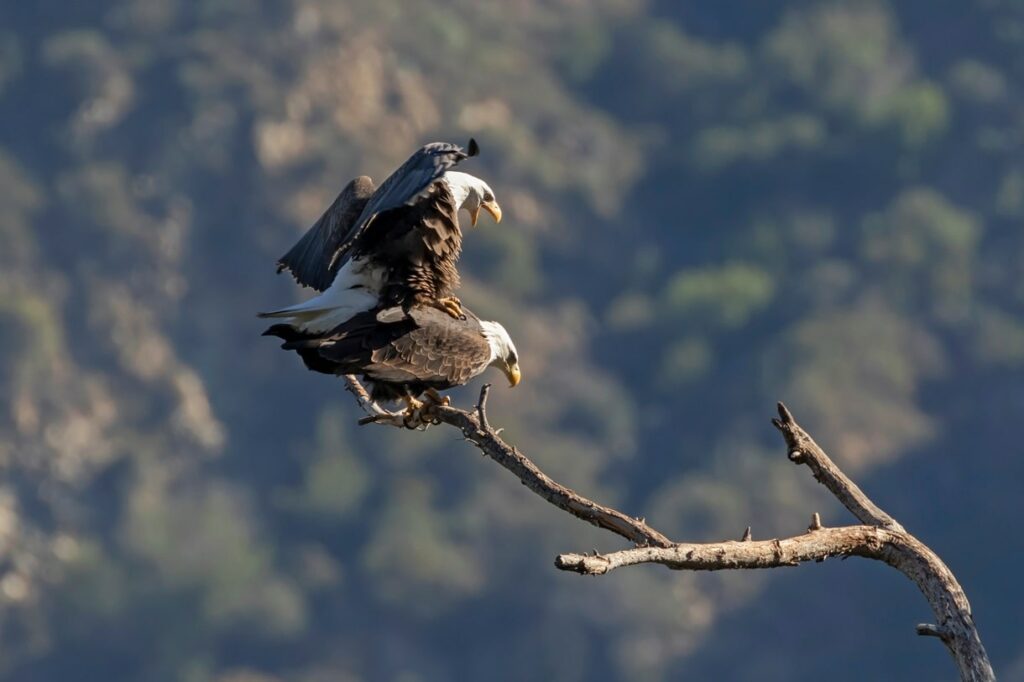Eagles are large raptors found on every continent except Antarctica. Their large bodies and heads, with powerful beaks and talons, make them fearsome predators perfect for capturing prey on land and in the water.
Most Eagles are in Europe, Asia, and Africa, but a few are in North America, South America, and Australia. Depending on the species, eagles can live from 15 to 35 years in the wild and up to 50 years in captivity.
Eagles mate for life, but in species like the Bald Eagle, whose population has increased over the last few decades, the rate of infidelity and divorce has also increased. The social complexity of eagle mating is more complex than researchers initially believed.

Do All Species of Eagle Mate for Life?
All Eagle species mate for life, and within bonded pairs, both males and females work together and share the labor of nest building, incubating, and feeding their offspring. These pairs may remain together for twenty or thirty years, adding to their nests annually.
Eagles build their nests in tall trees, and each year, they add on to the nest. Their nests average four to six feet in diameter (1.2 to 1.8 meters) and three feet deep (0.9 meters).
After twenty years or more, their nests can be around 9 feet in diameter (2.7 meters) and 12 feet tall (3.6 meters), weighing 2 tons (1,800 kilograms).
This cooperative behavior in mated pairs produces many offspring, but some unmated eagles exhibit behaviors uncharacteristic of typical eagle monogamy. In addition, some females may be more polyandrous than monogamous.
During the breeding season, unmated male eagles or mated males from another pair may interfere with a mated eagle pair and fertilize the female’s eggs, leaving her mate to raise another male’s offspring.
Sometimes, male eagles may become “deadbeat dads” that do not forage for food for their females and young. Instead, they may become neglectful of their nest and mate. When that happens, eagle divorce may occur when the female seeks a new and more supportive mate.
When Do Eagles Mate?
Eagles generally start mating when they reach four or five years of age. Once they fledge, they typically remain in groups with other juvenile siblings close to their parents for at least one year, sometimes more.
Mated eagle pairs begin building or doing maintenance on their nests in the fall, then lay their eggs throughout the winter months. In the mid-Atlantic United States, Bald Eagles mate from mid-December through mid-February.
The mating season starts later in more northern latitudes. In Alaska, Bald Eagles begin laying eggs in April. The timing of breeding seasons varies by species and location. A severe winter storm can delay the breeding season of an established mating pair by destroying their nest.
Some eagle species, like the Harpy Eagle, do not breed annually. These eagles may only produce offspring once every two or three years because the time it takes for their young to become independent is around ten months.
How Do Eagles Mate?
Eagles perform spectacular aerial acrobatics during courtship by flying high and locking talons, then falling and spinning through the air. These death-defying “cartwheel courtship flights” look dangerous and result in the birds hitting the ground if they do not break apart fast enough.
Once the dangerous courtship flight is over, the mated eagles preen each other until they are ready to fertilize and lay their eggs in the prepared nest. As in other bird species, male eagles climb onto the females’ backs to fertilize the eggs.
How Often Do Eagles Mate?
Eagle pairs may copulate several times daily. This way, the mated male can be sure he is fertilizing the eggs. Sometimes, if the mated male is away from the nest during the breeding season, an unmated male may slip into the nest and mate with the female.
Males may also “cheat” on their mated female and visit the nest of a different female to attempt mating with her. While fidelity between mated pairs is high, researchers have observed a small percentage of “cheating” among mates.
What Happens if an Eagle Loses Its Mate?
When an eagle loses its mate, it does not spend time mourning the loss. Instead, they will seek out another mate almost immediately.
If a female loses her mate during the breeding season while she is incubating the eggs or standing guard over the chicks, it may mean that the eggs or young will not survive. The females guard the nest aggressively while the males forage for food to feed the female.
Sometimes, an unmated eagle will quickly appear to replace the dead mate. If this occurs, the female may save her offspring with the help of the new male that will forage for her if she accepts him.
Without a male, the female would have to leave the nest to forage for food alone, leaving the eggs and chicks vulnerable to predation. Many species target eagle eggs and chicks, including crows, owls, and other raptors.
Do Eagles Mate with Other Species?
Crossbreeding between different species of eagles within the same genus does occur, but rarely. These crossbred individuals have characteristics of both species, and the hybrid offspring may be able to reproduce.
Little research is available on hybrid eagles, but scientists have documented several cases of hybridization in the genera of Haliaeetus and Aquila. Crossbreeding occurs when eagles do not encounter many birds of their own species, resulting in mixed-species pairs.
